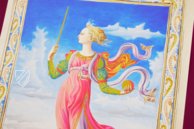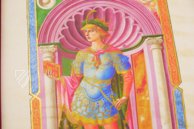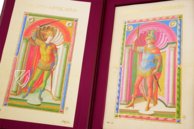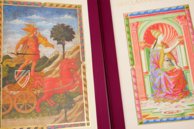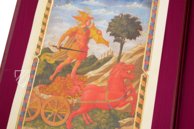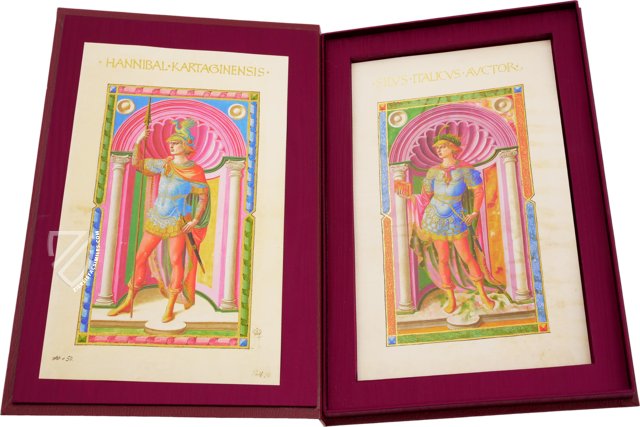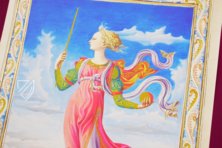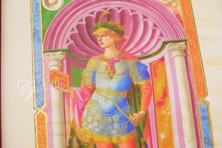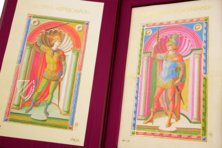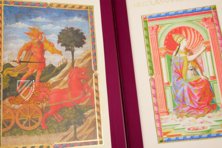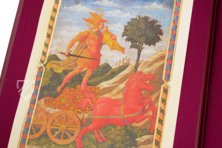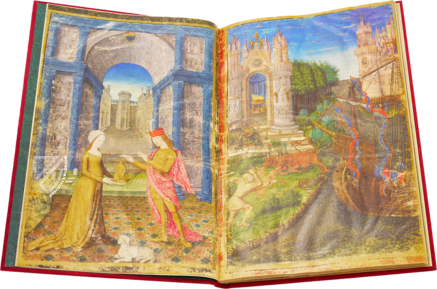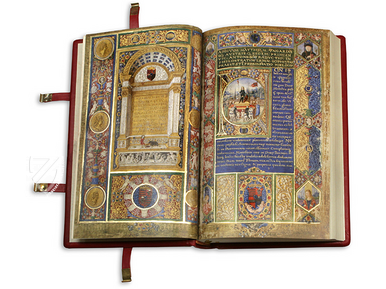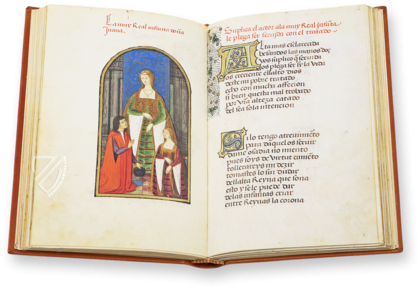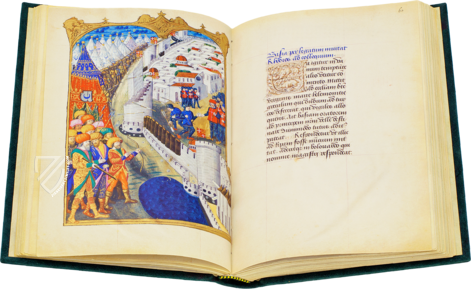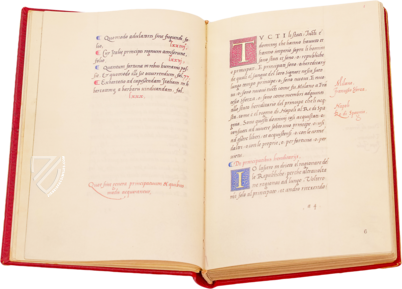Silius Italicus: De Secundo Bello Punico Poema
(under 1,000€)
These seven grandiose pages attest to the splendor of the manuscript of which they were once a part: one of the most valuable Italian editions of the Punica by Silius Italicus from the 15th century. This epic by the famous ancient Roman poet about the Second Punic War was rediscovered and well-received in the Renaissance. This splendidly furnished edition, illustrated by Francesco Di Stefano, was in the private collection of Pope Nicolaus V. The seven surviving pages present the allegorical figures of Rome and Carthage, portraits of Silius Italicus, Hannibal, Scipio Africanus, and Pope Nicolaus V, as well as a depiction of Mars, the god of war.
Silius Italicus: De Secundo Bello Punico Poema
These seven grandiose pages attest to the splendor of the manuscript of which they were once a part: one of the most valuable Italian editions of the Punica by Silius Italicus from the 15th century. This epic by the famous ancient Roman poet about the Second Punic War was rediscovered and well-received in the Renaissance. This splendidly furnished edition, illustrated by Francesco Di Stefano, was in the private collection of Pope Nicolaus V. The seven surviving pages present the allegorical figures of Rome and Carthage, portraits of Silius Italicus, Hannibal, Scipio Africanus, and Pope Nicolaus V, as well as a depiction of Mars, the god of war.
The Ancient War Epic
In his famous Punica, also known under the title De bello italic, the ancient Roman poet Silius Italicus tells about the Second Punic War. This epic made the author famous. The text, which was rediscovered and adapted in the Renaissance, celebrated the greatness and power of Rome and its heroes.
In the Pope’s Possession
Pope Nicolaus V (1447–55) owned a richly-decorated codex of the Punica. This came along with the rest of Nicolaus V’s significant collection to the Dominican Convent of St. Peter and Paul in Venice. The excessively-decorated and famous manuscript was finally the victim of robbers and thus only seven pages survive today. Nonetheless, these are a grandiose attestation to the overwhelming splendor of the former codex. Today, these pages are stored in two different collections: the Biblioteca Nazionale Marciana in Venice and the Hermitage in St. Petersburg.
Seven Masterpieces of Renaissance Painting
The Silius Italicus manuscript originated ca. 1448 in Florence. The blessed artist of the work was Francesco Di Stefano, called Il Pesellino, one of the most significant artists of the Florentine Quattrocento. Francesco Di Stefano was influenced by Italy’s greatest masters, Filippo Lippi and Fra Angelico, inter alia. The seven surviving pages measuring 33 x 20 cm present gorgeous Renaissance-style depictions in full-page miniatures. Magnificent decorative frames, which imitate marble and other materials, surround the allegorical figures of Rome and Carthage, portraits of Silius Italicus, the generals Hannibal and Scipio Africanus, Pope Nicolaus V, and the god Mars on a war chariot drawn by two horses in a marvelous landscape. They are all presented in profile as elegant figures in colorful garments, each standing in a bright alcove.
Codicology
- Alternative Titles
- Silius Italicus
- Size / Format
- 14 pages / 33.0 × 20.2 cm
- Origin
- Italy
- Date
- Around 1448
- Epochs
- Style
- Language
- Artist / School
- Francesco Di Stefano (Il Pesellino)
Filippo Lippi
Fra Angelico - Previous Owners
- Pope Nicholas V
Dominican monastery of Saints John and Paul in Venice
Silius Italicus: De Secundo Bello Punico Poema
Scipio Africanus
Wearing a stylized helmet with a spined fish and the wings of an eagle, Scipio Africanus triumphantly holds up a sword – the tip of which pierces the gold leaf of the frame that surrounds him – as he stands in front of an alcove flanked by two green columns. Aside from being one of Rome’s greatest heroes, Scipio is regarded as one of the best military commanders and strategists of all time whose most famous achievement was defeating the Carthaginian general Hannibal at the Battle of Zama in 202 BC.
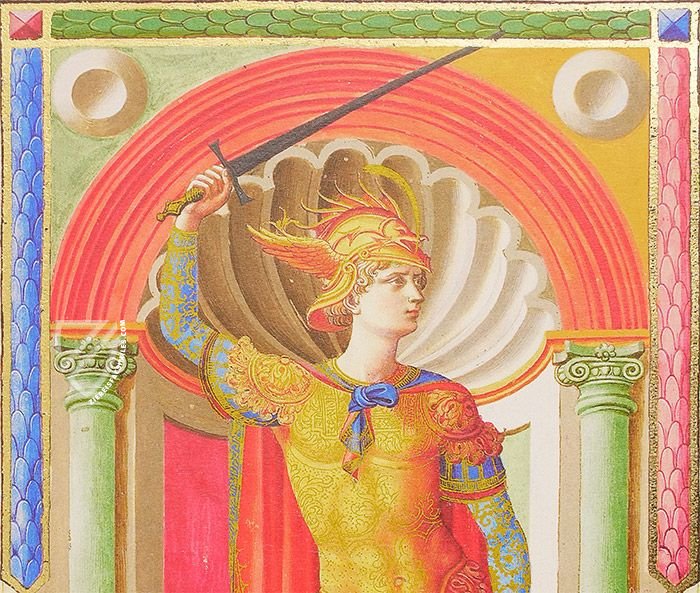
Silius Italicus: De Secundo Bello Punico Poema
Mars
The Roman god of war is being drawn by two red horses on a four-wheeled chariot, which he appears to float above rather than stand on. Sword in hand, Mars is dressed in stylized armor with a cape and carries and eight-sided Grecian shield. A strong fortress with many strong towers is perched on a hill in the distance amidst a splendid landscape.
The standard pattern of a Roman army camps served both a defensive and a religious purpose: the commander’s headquarters at the center of the camp was also where auspices were taken and sacrifices made. It was believed that victory was dependent on a combination of personal and collective virtus or “manly virtue” and divine will; it was the sign of a special relationship with the gods, especially Mars.
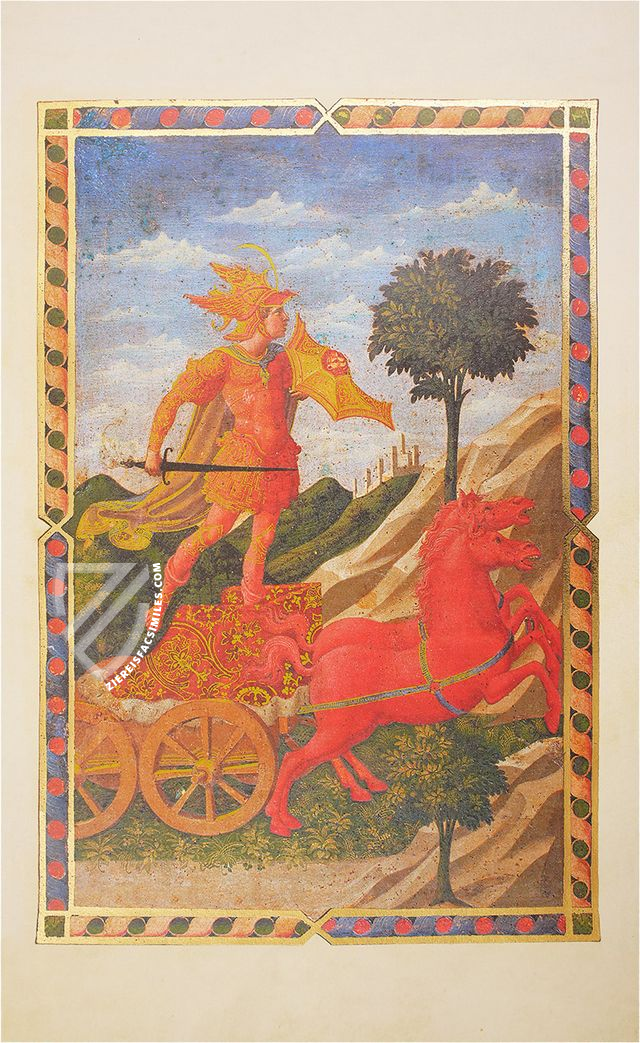
#1 Silius Italicus
Languages: English, French, Spanish
(under 1,000€)
- Treatises / Secular Books
- Apocalypses / Beatus
- Astronomy / Astrology
- Bestiaries
- Bibles / Gospels
- Chronicles / History / Law
- Geography / Maps
- Saints' Lives
- Islam / Oriental
- Judaism / Hebrew
- Single Leaf Collections
- Leonardo da Vinci
- Literature / Poetry
- Liturgical Manuscripts
- Medicine / Botany / Alchemy
- Music
- Mythology / Prophecies
- Psalters
- Other Religious Books
- Games / Hunting
- Private Devotion Books
- Other Genres
- Afghanistan
- Armenia
- Austria
- Belgium
- Belize
- Bosnia and Herzegovina
- China
- Colombia
- Costa Rica
- Croatia
- Cyprus
- Czech Republic
- Denmark
- Egypt
- El Salvador
- Ethiopia
- France
- Germany
- Greece
- Guatemala
- Honduras
- Hungary
- India
- Iran
- Iraq
- Israel
- Italy
- Japan
- Jordan
- Kazakhstan
- Kyrgyzstan
- Lebanon
- Liechtenstein
- Luxembourg
- Mexico
- Morocco
- Netherlands
- Palestine
- Panama
- Peru
- Poland
- Portugal
- Romania
- Russia
- Serbia
- Spain
- Sri Lanka
- Sweden
- Switzerland
- Syria
- Tajikistan
- Turkey
- Turkmenistan
- Ukraine
- United Kingdom
- United States
- Uzbekistan
- Vatican City
- A. Oosthoek, van Holkema & Warendorf
- Aboca Museum
- Ajuntament de Valencia
- Akademie Verlag
- Akademische Druck- u. Verlagsanstalt (ADEVA)
- Aldo Ausilio Editore - Bottega d’Erasmo
- Alecto Historical Editions
- Alkuin Verlag
- Almqvist & Wiksell
- Amilcare Pizzi
- Andreas & Andreas Verlagsbuchhandlung
- Archa 90
- Archiv Verlag
- Archivi Edizioni
- Arnold Verlag
- ARS
- Ars Magna
- ArtCodex
- AyN Ediciones
- Azimuth Editions
- Badenia Verlag
- Bärenreiter-Verlag
- Belser Verlag
- Belser Verlag / WK Wertkontor
- Benziger Verlag
- Bernardinum Wydawnictwo
- BiblioGemma
- Biblioteca Apostolica Vaticana (Vaticanstadt, Vaticanstadt)
- Bibliotheca Palatina Faksimile Verlag
- Bibliotheca Rara
- Boydell & Brewer
- Bramante Edizioni
- Bredius Genootschap
- Brepols Publishers
- British Library
- C. Weckesser
- Caixa Catalunya
- Canesi
- CAPSA, Ars Scriptoria
- Caratzas Brothers, Publishers
- Carus Verlag
- Casamassima Libri
- Centrum Cartographie Verlag GmbH
- Chavane Verlag
- Christian Brandstätter Verlag
- Circulo Cientifico
- Club Bibliófilo Versol
- Club du Livre
- CM Editores
- Collegium Graphicum
- Collezione Apocrifa Da Vinci
- Comissão Nacional para as Comemorações dos Descobrimentos Portugueses
- Coron Verlag
- Corvina
- CTHS
- D. S. Brewer
- Damon
- De Agostini/UTET
- De Nederlandsche Boekhandel
- De Schutter
- Deuschle & Stemmle
- Deutscher Verlag für Kunstwissenschaft
- DIAMM
- Droz
- E. Schreiber Graphische Kunstanstalten
- Ediciones Boreal
- Ediciones Grial
- Ediclube
- Edições Inapa
- Edilan
- Editalia
- Edition Deuschle
- Edition Georg Popp
- Edition Leipzig
- Edition Libri Illustri
- Editiones Reales Sitios S. L.
- Éditions de l'Oiseau Lyre
- Editions Medicina Rara
- Editorial Casariego
- Editorial Mintzoa
- Editrice Antenore
- Editrice Velar
- Edizioni Edison
- Egeria, S.L.
- Eikon Editores
- Electa
- Emery Walker Limited
- Enciclopèdia Catalana
- Eos-Verlag
- Ephesus Publishing
- Ernst Battenberg
- Eugrammia Press
- Extraordinary Editions
- Fackelverlag
- Facsimila Art & Edition
- Facsimile Editions Ltd.
- Facsimilia Art & Edition Ebert KG
- Faksimile Verlag
- Feuermann Verlag
- Folger Shakespeare Library
- Franco Cosimo Panini Editore
- Friedrich Wittig Verlag
- Fundación Hullera Vasco-Leonesa
- G. Braziller
- Gabriele Mazzotta Editore
- Gebr. Mann Verlag
- Gesellschaft für graphische Industrie
- Getty Research Institute
- Giovanni Domenico de Rossi
- Giunti Editore
- Graffiti
- Grafica European Center of Fine Arts
- Guido Pressler
- Guillermo Blazquez
- Gustav Kiepenheuer
- H. N. Abrams
- Harrassowitz
- Harvard University Press
- Helikon
- Hendrickson Publishers
- Henning Oppermann
- Herder Verlag
- Hes & De Graaf Publishers
- Hoepli
- Holbein-Verlag
- Houghton Library
- Hugo Schmidt Verlag
- Idion Verlag
- Il Bulino, edizioni d'arte
- ILte
- Imago
- Insel Verlag
- Insel-Verlag Anton Kippenberger
- Instituto de Estudios Altoaragoneses
- Instituto Nacional de Antropología e Historia
- Introligatornia Budnik Jerzy
- Istituto dell'Enciclopedia Italiana - Treccani
- Istituto Ellenico di Studi Bizantini e Postbizantini
- Istituto Geografico De Agostini
- Istituto Poligrafico e Zecca dello Stato
- Italarte Art Establishments
- Jan Thorbecke Verlag
- Johnson Reprint Corporation
- Josef Stocker
- Josef Stocker-Schmid
- Jugoslavija
- Karl W. Hiersemann
- Kasper Straube
- Kaydeda Ediciones
- Kindler Verlag / Coron Verlag
- Kodansha International Ltd.
- Konrad Kölbl Verlag
- Kurt Wolff Verlag
- La Liberia dello Stato
- La Linea Editrice
- La Meta Editore
- Lambert Schneider
- Landeskreditbank Baden-Württemberg
- Leo S. Olschki
- Les Incunables
- Liber Artis
- Library of Congress
- Libreria Musicale Italiana
- Lichtdruck
- Lito Immagine Editore
- Lumen Artis
- Lund Humphries
- M. Moleiro Editor
- Maison des Sciences de l'homme et de la société de Poitiers
- Manuscriptum
- Martinus Nijhoff
- Maruzen-Yushodo Co. Ltd.
- MASA
- Massada Publishers
- McGraw-Hill
- Metropolitan Museum of Art
- Militos
- Millennium Liber
- Müller & Schindler
- Nahar - Stavit
- Nahar and Steimatzky
- National Library of Wales
- Neri Pozza
- Nova Charta
- Oceanum Verlag
- Odeon
- Orbis Mediaevalis
- Orbis Pictus
- Österreichische Staatsdruckerei
- Oxford University Press
- Pageant Books
- Parzellers Buchverlag
- Patrimonio Ediciones
- Pattloch Verlag
- PIAF
- Pieper Verlag
- Plon-Nourrit et cie
- Poligrafiche Bolis
- Presses Universitaires de Strasbourg
- Prestel Verlag
- Princeton University Press
- Prisma Verlag
- Priuli & Verlucca, editori
- Pro Sport Verlag
- Propyläen Verlag
- Pytheas Books
- Quaternio Verlag Luzern
- Reales Sitios
- Recht-Verlag
- Reichert Verlag
- Reichsdruckerei
- Reprint Verlag
- Riehn & Reusch
- Roberto Vattori Editore
- Rosenkilde and Bagger
- Roxburghe Club
- Salerno Editrice
- Saltellus Press
- Sandoz
- Sarajevo Svjetlost
- Schöck ArtPrint Kft.
- Schulsinger Brothers
- Scolar Press
- Scrinium
- Scripta Maneant
- Scriptorium
- Shazar
- Siloé, arte y bibliofilia
- SISMEL - Edizioni del Galluzzo
- Sociedad Mexicana de Antropología
- Société des Bibliophiles & Iconophiles de Belgique
- Soncin Publishing
- Sorli Ediciones
- Stainer and Bell
- Studer
- Styria Verlag
- Sumptibus Pragopress
- Szegedi Tudomànyegyetem
- Taberna Libraria
- Tarshish Books
- Taschen
- Tempus Libri
- Testimonio Compañía Editorial
- Thames and Hudson
- The Clear Vue Publishing Partnership Limited
- The Facsimile Codex
- The Folio Society
- The Marquess of Normanby
- The Richard III and Yorkist History Trust
- Tip.Le.Co
- TouchArt
- TREC Publishing House
- TRI Publishing Co.
- Trident Editore
- Tuliba Collection
- Typis Regiae Officinae Polygraphicae
- Union Verlag Berlin
- Universidad de Granada
- University of California Press
- University of Chicago Press
- Urs Graf
- Vallecchi
- Van Wijnen
- VCH, Acta Humaniora
- VDI Verlag
- VEB Deutscher Verlag für Musik
- Verlag Anton Pustet / Andreas Verlag
- Verlag Bibliophile Drucke Josef Stocker
- Verlag der Münchner Drucke
- Verlag für Regionalgeschichte
- Verlag Styria
- Vicent Garcia Editores
- W. Turnowski Ltd.
- W. Turnowsky
- Waanders Printers
- Wiener Mechitharisten-Congregation (Wien, Österreich)
- Wissenschaftliche Buchgesellschaft
- Wissenschaftliche Verlagsgesellschaft
- Wydawnictwo Dolnoslaskie
- Xuntanza Editorial
- Zakład Narodowy
- Zollikofer AG






